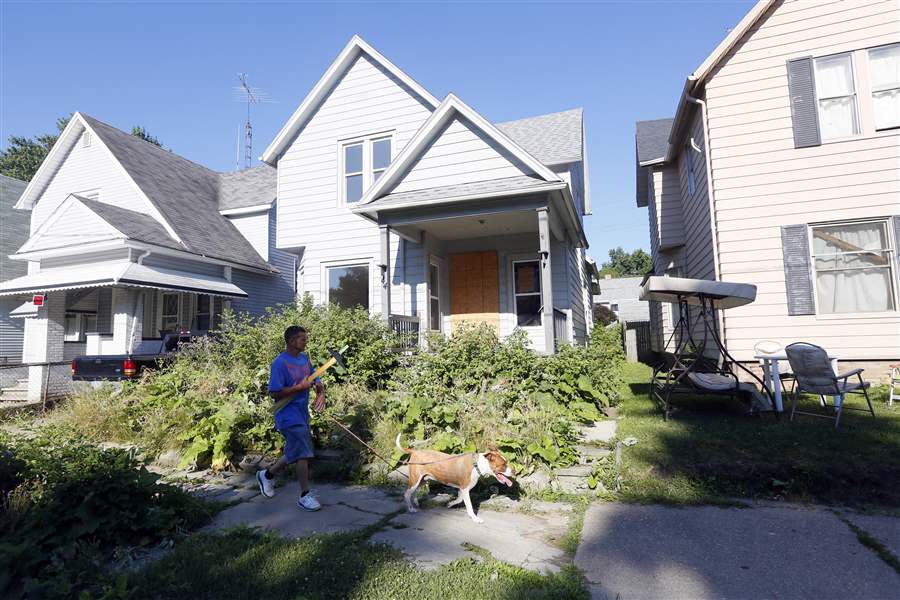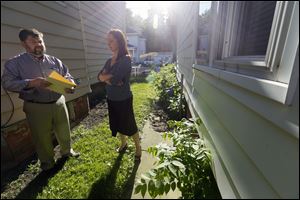
Lawns, lack of response contribute to Toledo blight
City residents angry over slow response to out-of-control grass
7/14/2014
Robert Sims walks past 44 Garfield Place in East Toledo with his dog Papa. Neighborhood residents began complaining about the high grass there in May, 2013. The city of Toledo finally cut the grass last week.
The Blade/Amy E. Voigt
Buy This Image

Robert Sims walks past 44 Garfield Place in East Toledo with his dog Papa. Neighborhood residents began complaining about the high grass there in May, 2013. The city of Toledo finally cut the grass last week.
At nearly 6 feet in height, the grass in the backyard of 44 Garfield Place defied Councilman Mike Craig’s best efforts to touch its tips.
“You can’t even go in there with a regular mower,” Mr. Craig said. “There is absolutely no excuse for this.”
Since May, 2013, 16 complaints by residents about the house at 44 Garfield Place for high grass, weeds, junk, and abandonment have been logged into CityWorks, the city’s software for addressing service requests. That May, the house had a priority ranking of “medium;” by October, the property was listed as an “emergency/safety hazard.”
Three complaints from October, 2013, to May, 2014, were designated “work order issued” and “marked completed.” But Deb Pesina and other Block Watch members say city inspectors did no more than visit, flag the home for maintenance, and leave. The grass — home to rats, raccoons, and a mattress or two — was finally cut last week, more than a year later.
Ms. Pesina, who started calling about the blighted house in 2006, said the city’s lack of response was another roadblock to the East Toledo community’s efforts to maintain the neighborhood. Particularly in the north, south, and east sides, Toledo residents are raising their voices about unsightly lawns, sprouting steadily higher on foreclosed properties and city-owned lots, that the city is failing to address.
RELATED CONTENT: Read more from The Ugly Truth About Toledo series
In a letter to Mayor D. Michael Collins, District 4 council member Paula Hicks-Hudson wrote that mowing the grass, a “basic service” the city is expected to provide, has become something for which her constituents have to beg.
“I have been patient since grass started growing in March, and here we are in July and it doesn't seem that there is a handle on this problem,” Ms. Hicks-Hudson said.
Sherry Walker, a former member of ONE Village Council, said the grass on the corner of Locust and Delaware was so high it was obstructing traffic. Some of her neighbors have been irritated enough with offending lawns that they paid to have them mowed, or mowed the lawns themselves.
ONE Village Council president Beth Lewandowski said the tall grass has prompted concern for residents with respiratory problems and allergies, and for children at play. Her neighbors and other residents in the North End have spotted what they say is a zoo’s worth of rats, raccoons, opossums, and even groundhogs sneaking around in the weeds.
“You never know what you’re going to find in there,” Ms. Walker said. “It’s really bad this year, like nobody cares.”

Councilman Mike Craig stands with Kimberly Baker, a city of Toledo legislative aide, next to 44 Garfield Place in East Toledo. Mr. Craig said the grass there was nearly 6-feet tall and area residents said the grass contained rats, raccoons, and mattresses.
Even when the grass is cut in her neighborhood, council member Lindsay Webb said, workers will leave the trimmings and other debris behind, or only take care of the front when the back is difficult to access.
The city has been “playing catch-up” with grass-related requests since the start of the grass-growing season in March, said Chris Zervos, the city’s commissioner for building inspection.
Since its employment agency went out of business, the city’s Beautification Action Team has been left with fewer temporary workers than usual, he said.
Mayor Collins, writing to council members, also attributed the delay in response to council staff members emailing constituents’ complaints instead of logging them directly into CityWorks — a poor excuse for a “broken system,” Mr. Craig said.
While it is homeowners’ responsibility to take care of their lawns, the city is authorized to go onto a lot if homeowners do not abate the problem. Still, Mr. Zervos said, the BAT should be deployed only as a last resort, and not to do the work of a negligent homeowner.
But finding and holding homeowners responsible can be as much of a nuisance as the grass itself.
Mr. Craig said banks and mortgage companies occasionally leave foreclosed properties in the name of the original owner, who then receives the legal notices and fines for property violations despite having no connection to the home. The resulting confusion can mean long delays in taking care of the grass and other problems while the city hunts for the owner, Mr. Zervos said.
Some properties remain unattended to because people are either unaware that a resource exists to address their complaints, or are reluctant to have the city take issue with their own properties while inspecting the offending home, Ms. Lewandowski said. Occasionally, however, their silence is a matter of apathy.
“People are so accustomed to seeing high grass and abandoned houses that it doesn’t even register to them to call anymore,” she said.
The mayor’s new T-Town initiative, which goes live on July 24, will create a task force to handle blight remediation by identifying properties that are in need of maintenance.
But Ms. Lewandowski said that the initiative will depend on the city’s responsiveness to residents who call in, and its willingness to work with banks and absentee landlords responsible for the upkeep of blighted homes.
In a committee meeting with elected officials scheduled for July 28, ONE Village Council members intend to discuss housing and long-term strategies for how the city and residents can find an equitable way to divide the work ahead.
“I have no problem doing my part, but we can’t do what the city needs to do,” Ms. Walker said.
Contact Jennifer Gersten at: jgersten@theblade.com, 419-724-6050, or on Twitter @jenwgersten.